

Tao Te Ching
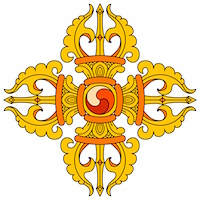
Tibetan Vajrayana (वज्रयान) Lineage
Tibet could easily claim title as the most religious country in the history of the world. During hundreds of years of Tibetan history, more than 25% of the population were either monks or nuns with more living as householder or solitary yogis, traveling wanderers, or independent sages. Their religious perspective pervaded all aspects of life including politics, music, literature, art, education, and the family. This led to some superstition and dogmatic belief but also to extensive, profound, and effective spiritual practices; to life-changing philosophies, day-to-day compassion and a unique kind of inspiration that’s now sweeping the world.
People (45)
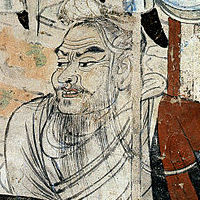
Vimalkirti विमल
600 – 500 BCE
Close disciple of the Buddha who extended his teachings to common people
One of the Buddha’s closest and most important disciples, Vimalkirti became known for his wisdom and ability to teach Dharma to not only monastics but to everyday, common people. Like the Buddha and born into a wealthy family, he also renounced his position and possessions but his teaching and influence extended back to people not willing to renounce so much. This helped shape the Buddhist traditions into welcoming everyone. Although sometimes considered legendary, teachings attributed to him on emptiness became a central theme in Buddhist philosophy and most traditions consider him an historical figure and a founding influence on the Chan and Zen traditions.
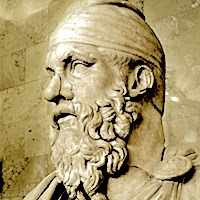
Abaris Hyperboreios βαρις Ὑπερβόρειος
595 – 595 BCE
Legendary sage, Mongol shaman, and catalyst for the beginning of Western Civilization
Abaris Hyperboreios, Skywalker βαρις Ὑπερβόρειος (c. 595 BCE)
Legendary sage, Mongol shaman, ancient ambassador of Eastern Wisdom to the West, “master of incantations,” and “Overcomer of Obstacles;” One of the earliest druids, Abaris became a famous and greatly respected sage in pre-Socratic Greece. Plato described him as a great physician who healed both body and mind, Herodotus depicted him as a magical arrow traveler, and anecdotes written by Pindar, Iamblichus, Pausanias, and Suidas characterized him as sorcerer, prophet, shamanistic missionary, purifier and bringer of balance to the earth. Peter Kingsley links him to the early formation of Tibetan civilization as well as being the soul-brother of Pythagoras, the spark that lifted the Greeks out of their primitive state, and the catalyst for the beginning and momentum of Western Civilization.
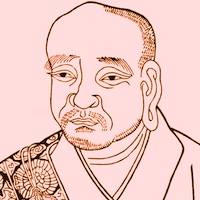
Ashvaghosha སློབ་དཔོན་དཔའ་བོ། (Aśvaghoṣa)
80 – 150 CE
"Bodhisattva with a Horse-Voice" (because even horses listened to his talks)
Considered the first Sanskrit dramatist, one of the greatest Indian poets, and writer of epics that rivaled the Ramayana; Ashvaghosha—because of losing a debate and having to become a Buddhist—transformed from a wandering ascetic into one of his age's most influential philosophers. His writings ranged from religious poems considered a virtue to just read... to political themes critical of caste and Vedic-imposed inequity. He became spiritual advisor to the emperor, Kanishka who helped develop the Silk Route and spread Buddhism into China.
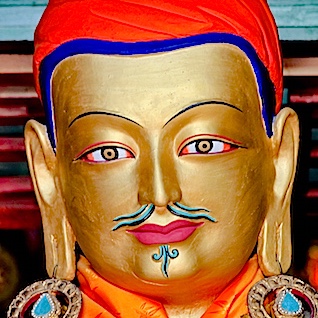
Songtsen Gampo སྲོང་བཙན་སྒམ་པོ
569 – 649 CE
Founder of the Tibetan nation, Songtsen Gampo unified Tibet, introduced Buddhism, many new cultural and technological improvements, created the Tibetan alphabet, the first constitution and model laws. After winning a war against China and influence over Nepal, he was given Nepalese and Chinese princess wives who helped him establish trade with surrounding countries and a golden age for Tibet. In Tibetan tradition, both wives are considered incarnations of Tara, the Goddess of Compassion, and Songtsen Gampo as a manifestation of the bodhisattva, Avalokiteśvara.
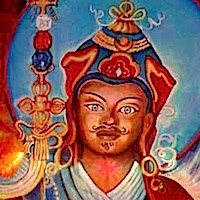
Padmasambhava པདྨཱ་ཀ་ར། ("The Lotus-Born", Guru Rinpoche)
8th century CE
Known as “The Second Buddha” and founder of Tibetan Buddhism the first Buddhist monastery in Tibet, and the Nyingma school; Padmasambhava came to Tibet at the request of King Trisong Detsen. Venerated also in northern India, Bhutan, and Nepal; Padmasambhava became famous for subduing “demonic forces” that prevented Buddhist teaching from becoming rooted in Tibet. Rather than conquering these negative influences, he took the tantric approach of transforming the demons into protectors. His name and symbolism comprise one of the most common and popular mantra-prayers in Tibetan Buddhism and is believed to communicate and inspire sacred teachings of transformation.
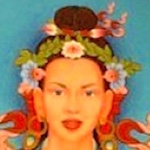
Yeshe Tsogyal ཡེ་ཤེས་མཚོ་རྒྱལ (Sky Dancer)
777 – 837 CE
Believed to be the reincarnation of the Buddha's own mother, Yeshe Tsogyal is the most famous of the enlightened women of Tibet and considered a female Buddha manifesting in the world in a way to teach an enlightened path in everyday life. She appeared as ordinary girl, princess, prostitute, business woman, and enlightened guru. Given from the king, Trisong Detsen’s harem to Padmasambhava who freed her, she helped establish Buddhism in Tibet and concealed terma for future generations.
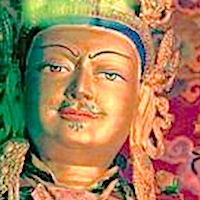
Trisong Detsän ཁྲི་སྲོང་ལྡེ་བཙན།
806 – 838 CE
Trisong Detsun, Ralpacan, Tritsuk Detsen, ཁྲི་གཙུག་ལྡེ་བཙན (806 - 838 CE)
One of the famous three “Dharma Kings” who brought Buddhism to Tibet and extended the Tibetan empire to its largest size encompassing parts of modern-day India, Nepal, Khotan, and a large territory in modern China including Sichuan, Xinjiang, and Gansu provinces; Trisong Detsun negotiated a peace treaty with the Uyguhurs in the north and with the Chinese in the east. He brought to Tibet hundreds of scholars, craftspeople, and translators who developed Tibetan literature, a Sanskrit-Tibetan dictionary, and translations of the Tripitaka, Buddhist commentaries, and ancient Tantras. He introduced weight and measurement systems from China, monastic religious organization from India, and set up a system of patronage for priests assigning support from 7 families for each Buddhist monk.
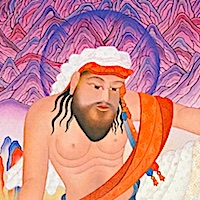
Nirgunapa ནིརྒུ་ཎ་པ།
(9th century)
"The Enlightened Moron" #57
Born into a low-caste family and inflicted with a moronic lassitude, depression, and such a lack of intelligence and skill that his parents thought it would have been better had he not been born; Nirgunapa sunk into the depths of suffering and despair. While unable to spark even enough motivation to beg for food, a teacher found him in a remote place and gave him enough food to survive. The teacher offered to give him a spiritual practice and Nirgunapa accepted with the condition that he not have to get up off his back. Exemplifying the principle of basic goodness in spite of possessing none of the materialistic qualities valued by society, he became a great teacher. While wandering through villages, when he met someone who asked him a question, he answered only by gazing into their eyes and crying which awoke in them a deep sense of compassion.
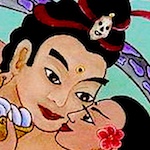
Dombipa
10th C. CE
Enlightened ruler of Magadha (Kashmir), Dombipa treated all his subjects like a “father would treat his only child” but his country suffered almost endless war, crime, famine, and poverty. He brought back prosperity, peace, and health but when he took a low caste “untouchable” as consort and started drinking large amounts of alcohol, the shocked people forced his abdication. After 12 years when the country’s problems returned, they begged him to return which he did “riding on a pregnant tiger” with his consort. To rule them again, he asked that they abandon the caste system. When they refused he went back into his meditation saying, “My only kingdom is the kingdom of truth.” This lineage continues with the Trungpa Tulkus.
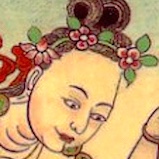
Manibhadra
10th C. CE
One of the 84 Mahasiddhas in the Tibetan Buddhist tradition and described as the “Happy Housewife’ siddha” and “Model Wife,” Manibhadra as a teenager met her teacher Kukkuripa and bravely followed him into the cremation grounds where she began practicing Vajrayana. Instead of leaving the conventional world to practice though, she married, had children and brought her spiritual practice into her daily life demonstrating the sacredness and enlightenment in the simple, ordinary world and becoming an exemplar to householders.
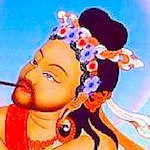
Nāropā
955 – 1040 CE
Born a high status Bengali Brahmin, Nāropā became a great debater, scholar, Nalanda abbot, and “Guardian of the Northern gate.” In a famous encounter with his teacher, Tilopa, he realized that he only understood the words of the teachings, not the true sense and began a journey that defines the criteria for lineage holders on this list. An important teacher to many enlightened teachers and mahasiddhas including Atisa, Maitripa, Dombipa, Marpa and many other Tibetans who took these teachings to Tibet where they flourished as they were destroyed in India by an Islamic invasion said to have killed over 400 million people.

Atisha ཨ་ཏི་ཤ་མར་མེ་མཛད་དཔལ་ཡེ་ཤེས་ (Atiśa Dīpaṃkara Śrījñāna)
980 – 1054 CE
One of the major figures in classical Buddhism, Atiśa inspired students and teachers from Tibet to Sumatra. Born into royalty in the capital of the Pala Empire, Atiśa became a monk and scholar said to have studied with more than 150 different teachers. Founder of the Kadam School, he traveled and taught widely. In The Seven Points of Mind Training he condensed Buddhist teachings into easy-to-remember slogans. The lineage of people using this technique includes Aesop, Balthasar Gracian, Ben Franklin, Erasmus, Yang Xiung as well as The Dhammapada.
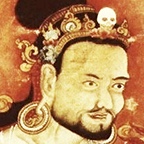
Tilopa
988 – 1069 CE
Born a king, Tilopa - like the Buddha - wasn’t that impressed by fame and fortune and left everything to go on a spiritual search. When he met the teacher Nagarjuna though, he was told to return to his kingdom and kingship. He saved his country during a war with non-violence. He later became a monk and scholar but another teacher, Matongha saw pride remaining from his royal caste and advised him to leave, go into the world, and take a job crushing sesame seeds during the day and procuring for a prostitute at night. This led to him becoming a great Mahasiddha, lineage holder and teacher to Naropa.
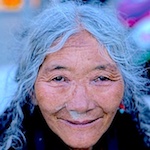
Niguma
11th C. CE
“Dakini of timeless awareness,” co-founder of the “secret lineage,” the Shangpa Kagyu school of Vajrayana Buddhism, wife and later disciple of mahasiddha Naropa, teacher to Marpa the translator; Niguma wrote 13 books basic to the Tibetan Buddhist tradition and had a deep and continuing influence on the foundations and practices of Buddhism in Tibet and other countries. One of the most important and influential teachers of her time, she established a complete set of spiritual practices called the Six Yogas of Niguma that is still practiced, studied and greatly appreciated today.
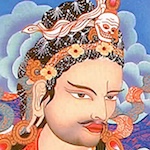
Thaganapa
11th C. CE
A low-caste, compulsive liar, Thaganapa’s entire life depended on his lies, deception, and scams. One day he met a monk who saw through, confronted, and challenged him to lead a better life. Thaganapa asked for teachings and the monk gave him a practice of using deception as an antidote to deception teaching him that everyone’s experience is deceiving from the beginning, that everything is a lie. He meditated on this for 7 years and then on all as emptiness until he became enlightened himself and taught a path of resolving paradox and unifying conflict.
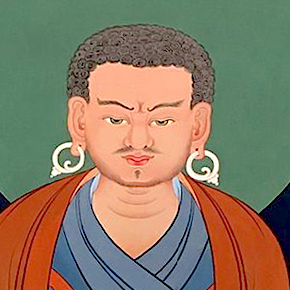
Marpa Lotsawa
1012 – 1097 CE
Founder of the Kagyu lineage of Tibetan Buddhism, teacher to the great Milarepa, businessman, farmer, family man and exemplar of enlightenment in everyday life; Marpa made many, perilous journeys to India and Nepal where he studied Vajrayana teachings, translating and bringing them back to Tibet. Wild, uncompromising, and outrageous; he flourished on physical dangers, psychological and spiritual challenge bringing “tasting the flavor of realization” into his translations that went to the depth of understanding rather than staying on the surface of the words.

Gesar of Ling གེ་སར་རྒྱལ་པོ།
11th century CE
Generally considered a real person in Tibet and Mongolia, a legend like King Arthur by western scholars, Gesar represents the heroism and wisdom necessary to overcoming the negative impulses in society, culture, and government that oppress people and prevents happiness from flourishing. Called the world's last living epic, the Gesar story includes more than 120 volumes, a million verses, and 2100 hours of oral performance - the largest body of epic literature in history. The Gesar epics derives from Indian Buddhism, native Tibetan Bön, and alchemical Taoism. Like Homer’s Iliad, they include performance, poetry, philosophy, education, politics and religion.
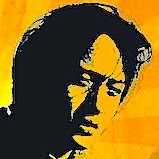
Milarepa རྗེ་བཙུན་མི་ལ་རས་པ།
1052 – 1135 CE
Black magician enemy-killing sorcerer transformed into a great Tibetan folk hero, poet, singer-songwriter and saint; Milarepa always refuted any hero worship or deification stressing his humble background and realization that anyone could achieve. Overcoming powerful, psychological demons, he left far behind fame, fortune, pleasure, power, even companionship and after many years of solitary meditation wandered throughout Tibet teaching and leading students to illuminating, egoless, complete sanity beyond the corruptions of a belief in a separate self. Profound without pretense, ageless because authentic, livable because so simple; Milarepa’s teaching and inspiration continues.
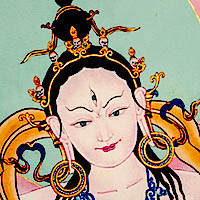
Machig Labdrön མ་གཅིག་ལབ་སྒྲོན།
1055 – 1149 CE
Nun, mother, wandering yogini, mind Stream emanation (tulku) of Yeshe Tsogyal that later became Jetsun Rinpoche; Machig Labdrön came from a Bön family and blended these shamanistic teachings with Buddhist Dzongchen to develop several Tibetan Vajrayana lineages as well as Mahamudra Chöd—a Prajñāpāramitā practice of “Cutting-Through-the-Ego” and experiencing emptiness. A child protege and scholar at a very early age, she left a comfortable and honored place in a monastery to wander and live with beggars and sleep wherever she found herself. Though criticized for having children, her teaching became so popular they spread from Tibet to India. In Tibet, it’s said she overcame the patriarchal bias of her times and gave teachings to as many as 500,000. Her lineage continues the Mahasiddha tradition of India and the Crazy Wisdom teachings of Tibet.
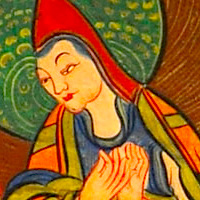
Sakya Pandita ས་སྐྱ་པཎྜ་ཏ་ཀུན་དགའ་རྒྱལ་མཚན། (Kunga Gyeltsen)
1182 – 1251 CE
Tibetan spiritual leader, scholar, doctor, scientist, poet, and politician; Sakya Pandita spent his early life as a monastic scholar and his late life applying his experience and understanding to the secular world as an advisor to the Mongol court. Born into a noble family; he began his religious studies at only 5 years old, became a monk at a very early age, and studied in Kashmir, India, and Nepal bringing an international view to his teachings. After Genghis Khan conquered Tibet in 1206, his descendants – drawn by the shamanistic similarities between the Sakya and Mongol traditions – brought Sakya Pandita into the government in an attempt to legitimize Mongol rule. At court he cured the Prince of a serious illness, was given authority over much of Tibet, and became the main agent of the Mongols in Tibetan affairs. He prevented more devastating invasions of Tibet, established an almost 100-year secular Sakya rule, and wrote some of the most influential Tibetan works of literature, many that are still part of the educational curricula today in Tibet, India, and Bhutan.
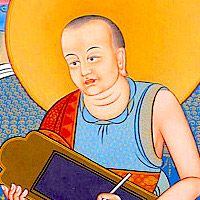
Mondup Sherab
12th century CE
Obscure, Tibetan 12th century monk and translator, student of Abhayadattashri
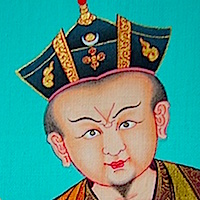
Karma Pakshi ཀརྨ་པཀྴི་
1204 – 1283 CE
Karma Pakshi ཀརྨ་པཀྴི་ (1204 – 1283)
The 2nd Gyalwa Karmapa and descended from a royal bloodline, Karma Pakshi brought the ancient, pre-Buddhist, shamanistic tulku (sprul sku) tradition into Tibetan Buddhism. Traveling widely in Tibet, Mongolia, and China he met Marco Polo but refused Kublai Khan’s request to stay in China. This incurred the emperor’s anger but he transformed it into a respect so deep that he was given the Mongolian name Pakshi (Bagshi) traditionally reserved for the highest Mongol shamans. Famous for his healing powers, sorcery, and ecstasy; he supported religious tolerance, non-Buddhist religions, and created immense balance and harmony. Bringing an ancient pillar of Dharma King Ralpacan (802-836 CE) known as "son of God" into the courtyard of his seat at Tsurphu, he further established his roots in the same ancient tradition that became the Orphic mysteries in pre-Socratic Greece and set up the conditions for the Dalai Lama’s blending of spiritual and secular leadership.
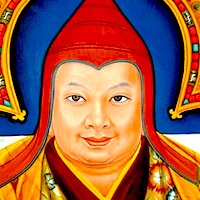
Dölpopa Shérap Gyeltsen དོལ་པོ་པ་ཤེས་རབ་རྒྱལ་མཚན།
1292 – 1361 CE
A teen-aged run-away on-the-road spiritual seeker; Dolpopa became one the most influential Tibetan teachers, one of the most original thinkers in all of Tibetan history, one of the greatest experts on the Shambhala Kalacakra teachings, and a figure so controversial he is still inspiring debate 700 years later. It’s said that when followers of the traditional lineages heard these teachings, they “experienced seizures and scrambled brains.” He described a True Self, a Buddha nature, a "Diamond Self,” an unconditioned, living truth and presence within all of us. He agreed with the traditional teaching that absolute and relative are both empty but taught that they are empty in different ways, the relative empty of self-nature; the absolute empty of other but not empty itself (the Zhentong view). His Jonang tradition was violently suppressed by the Tibetan government during the 17th century, banned by Gelug authorities, and attacked in an attempt to wipe it out by the Fifth Dalai Lama. It survived however as a powerful influence on all of Tibetan Buddhism and crucial to the 19th century Rimé (རིས་མེད) movement.
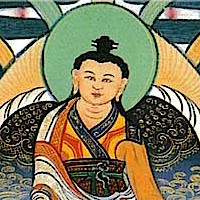
Longchenpa ཀློང་ཆེན་རབ་འབྱམས་པ། (Longchen Rabjampa, Drimé Özer)
1308 – 1364 CE
A child prodigy who could read and write at age 5, started learning the Nyingma tantras at 7, and was first ordained at 12; Longchenpa studied science as well as philosophy and Buddhism. One of ”the Three Omniscient Ones,”most important writer on the Dzogchen teachings, and abbot of the first Himalayan Buddhist monastery at Samye; he wrote more than 250 books and helped unify many diverse streams of Tibetan teachings into a comprehensive system known as Longchen Nyingthig. Considered an incarnation of a famous princess, Longchenpa was not only a monk but also fathered a son and daughter.
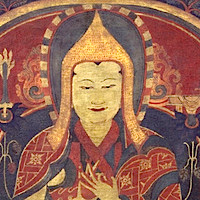
Tsongkhapa ཙོང་ཁ་པ། (Zongkapa Lobsang Zhaba, "the Man from Onion Valley")
1357 – 1419 CE
Born into a nomadic family with a Mongolian father and a Tibetan mother, Tsongkhapa became a famous teacher and founder of the Tibetan Buddhist Gelug school. His study and teachings stretched across many different lineages and he emphasized a blending of teachings, a unifying of different approaches, a balance of intellect and meditation. He used logic to undermine belief and open doors to insight much deeper than the words. His deep understanding of Buddhist teachings led to a fresh, innovative, and contemporary explication that became a dynamic influence on Tibetan Buddhism, culture, monasticism, and politics.
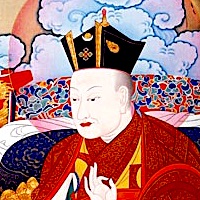
Wangchuk Dorje (9th Gyalwa Karmapa)
1556 – 1603 CE
Not only a great scholar and spiritual leader, Wangchuk Dorje became an important political influence. While helping the king of Sikkim settle a dispute, he founded three monasteries including Rumtek—still today the most important Kagyu monastery. As the 9th Karmapa and head of the Kagyu School of Tibetan Buddhism he travelled throughout Tibet, Mongolia, Bhutan, and Sikkim. He wrote many classic texts still studied and taught today.
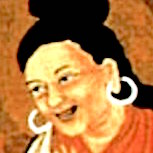
Shabkar Tsokdruk Rangdrol ཞབས་དཀར་ཚོགས་དྲུག་རང་གྲོལ།
1781 – 1851 CE
Prolific writer said to have written over 300 pages per day, famous lama, and student of the Mongolian king Chögyal Ngakgi Wangpo; Shabkar literally means “white feet,” a name given to him because his presence was so inspiration that it wherever he placed his feet became full of virtue and realization. Considered a reincarnation of Milarepa, he spent most of his life in retreats and composed “an ocean of songs.”
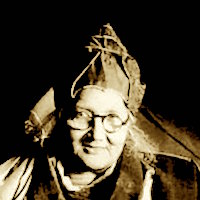
Jetsun Rinpoche, Shugsep ལོ་ཆེན་ཆོས་ཉིད་བཟང་མོ།
1852 – 1953 CE
Considered one of the most influential women in Tibetan history, personification of the great Tibetan women teachers, meditation master with more than 500 disciples; Jetsun Rinpoche when only six years old, began teaching with such insight and understanding that people were moved to tears. Radiating compassion and riding a large goat, she traveled through Tibet teaching, saving animals from slaughter with the money people gave her, and welcomed monks, nuns, laymen, women, and children. Beginning with her father who was extremely disappointed she wasn’t born a boy and later abandoned the family and continuing through her main teacher, Pema Gyatso; Jetsun Rinpoche successfully dealt with the patriarchy and sexism of her time and place.
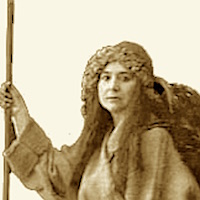
Alexandra David-Néel
1868 – 1969 CE
Author of over 30 books on Eastern religion, explorer, opera singer, and anarchist; Alexandra David-Néel became an important influence on the beat writers like Jack Kerouac and Allen Ginsberg as well as Eastern philosophy popularizers like Alan Watts. Only daughter of an exiled French political activist, she became serious about esoteric spiritual practices at an early age and by 15 was practicing austerities, fasting, and following the practices of ascetic saints. When 21, she became a Buddhist. A fearless explorer, she disguised herself as a beggar/monk, smeared her face with soot, and visited the highly forbidden city of Lhasa in 1924. Like Marco Polo, upon her return she became famous but unbelieved.
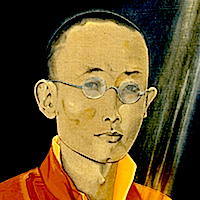
Gendün Chöphel དགེ་འདུན་ཆོས་འཕེལ།
1903 – 1951 CE
Child prodigy, iconoclast, artist, master debater, greatest Tibetan poet of the 20th century, Buddhist monk from an early age, modern Tibet’s first historian, and one of the most influential modern Tibetan intellectuals; Gendun Chopel kept a non-sectarian view throughout his life and challenged cultural, religious, and political dogmas. He lived with Nicholas and Helena Roerich for 2 years helping their son translate the Blue Annals which became a 1275 page book. He abandoned his monastic vows, drank alcohol, practiced and wrote the first Tibetan guide to love and sex. Having traveled and studied widely, he realized the importance of abandoning blind superstition and integrating Tibetan culture into the modern world. Instead of heading his warnings and developing Tibet in this way however, the conservative, status quo establishment had him whipped and imprisoned, ignored his message until the Chinese army arrived in Lhasa.
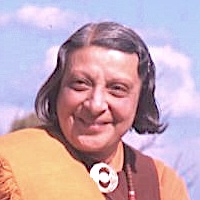
Li Gotami Govinda (Ratti Petit)
1906 – 1988 CE
Pioneering, fearless, artistic woman of wisdom
Photographer, painter, writer, composer, fearless traveler, and wise woman; Li Gotami was born into a wealthy Zoroastrian family in India, studied painting in Europe, became a close student of Abanindranath Tagore, and married Anagarika Govinda. A passionate traveler, she quickly broke out from the narrow boundaries expected of traditional Indian women. For many years, the couple lived near Kasar Devi a bohemian Mecca for their many friends—spiritual seekers like Walter Evans-Wentz, John Blofeld, Allen Ginsberg, Gary Snyder, Timothy Leary, Ralph Metzner, R. D. Laing, and Robert Thurman. Their many expeditions to Tibet included a perilous one to Tsaparang, the ancient capital Guge considered by some historians as the origin location of the Shambhala legends. Here she took photographs, did sketches, and made fresco tracings which preserve a record of how Tibet once was before the devastation of the Chinese invasion and extensive desecrations during the Cultural Revolution. In later life and in ill health, the couple moved to California where they were supported by Alan Watts and Suzuki Roshi's San Francisco Zen Center.
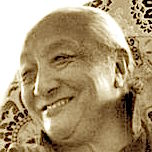
Dilgo Khyentse Rinpoche དིལ་མགོ་མཁྱེན་བརྩེ།
1910 – 1991 CE
"Mind" incarnation of Jamyang Khyentse Wangpo
Vajrayana master, poet, terton, scholar, and head of the one of Tibet’s main traditions; Khyentse Rinpoche became a major resource and driving force during Tibetan Buddhism’s transition out its 1000 years of isolation into the rest of the world. A descendent of Tibet’s legendary king, Trisong Detsen and a political minister father; he began an intense meditation practice and religious philosophy training when only 7 years old and then spent 13 years in caves and remote hermitages doing solitary retreats. An “archetype of spiritual teacher” and root teacher to hundreds of Tibet’s young lamas and to most of Tibet’s important modern teachers including Chogyam Trungpa, Dzongsqr Khyentse, the Dalai Lama, and Pema Chödrön; Khyentse Rinpoche’s wisdom and compassion continues to spread throughout the world.
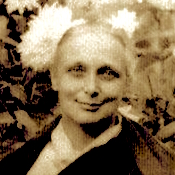
Freda Bedi, Sister Palmo
1911 – 1977 CE
Freda Bedi, Sister Palmo (1911 – 1977)
First Western woman to become a Tibetan Buddhist nun and married to a Sikh from Guru Nanak’s clan; Freda Bedi spoke before hundreds of thousands of people helping Gandhi and his national independence movement, was arrested and and spent months in prison held along with her children. People came to her by the thousands just for her blessing and she later worked for the United Nations Social Services, the Ministry of External Affairs, and the Tibetan Refugees Commission. Nehru asked her to be in charge of the Social Welfare Board in 1959 when the Dalai Lama and thousands of Tibetans arrived in India and she began studying with the 16th Karmapa. She helped establish the Young Lamas Home School and asked Chogyam Trungpa to train and become spiritual advisor to young monks there.
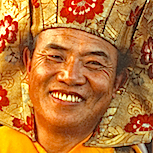
Karmapa XVI ཀརྨ་བཀའ་བརྒྱུད། (Rangjung Rigpe Dorje)
1924 – 1981 CE
“Karmapa” means “Activity of All Buddhas” and the Karmapas were both leaders of the Kagyu tradition and traditional teachers to the Chinese Ming Dynasty Emperors. In this life, it meant leading his people in their escape from Tibet into India, across Asia, and into the West. A teacher to the royal families of Sikkim and Bhutan, his rigorous training began when he was 7 years old and though a religious leader not focused on politics, he helped th Dalai Lama during trips to China and unsuccessful negotiations with Mao and the Chinese government. He continued the Black Crown ceremonies begun by the 5th Karmapa and the Chinese Emperor Yung Lo and in the early 1970’s predicted the Chinese invasion as well as the Western world’s openness and acceptance of Buddhism.
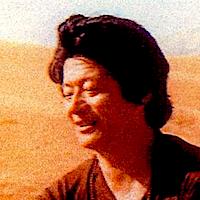
Thinley Norbu གདུང་སྲས་ཕྲིན་ལས་ནོར་བུ (Kyabjé Dungse)
1931 – 2011 CE
Oldest son of Nyingma head, Dudjom Rinpoche; Dzongsar Jamyang Khyentse Rinpoche's father, and Longchenpa/ Longchen Rabjam lineage manifestation; Thinly Norbu Rinpoche became one of the major teachers of ancient Tibetan wisdom to the modern, Western world. He first came to the usa in 1976; but, unlike most famous spiritual teachers of the time, he kept a lower profile, shunned publicity, and maintained a quiet life practicing and writing books.
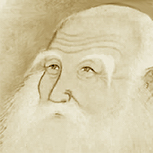
Shan Dao 山道
1933 CE –
Translator, entrepreneur, farmer, engineer, inventor, house-holder, and single father; Shan Dao grew up in a remote but culturally diverse village. Alienated from the materialism and militarism of his environment, he was drawn toward a spiritual path and at 4 years old began experiencing at first a mystical Christianity and later one more in harmony with Doestoevesky and Teilhard de Chardin. He practiced at first Rinzai and later Soto Zen, Tibetan Vajrayana Buddhism, and a Rimé Shambhala tradition which led to an immersion in the Tao Te Ching and the deep wisdom streams hidden but flowing in our many different religious cultures.
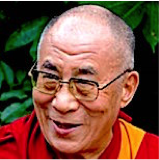
Dalai Lama XIV Tenzin Gyatso
1935 CE –
Born to a remote small farming family on a straw mat in a cowshed, the Dalai Lama became the world’s most popular political leader. He received the Nobel Peace Prize, the highest US honor of Congressional Gold Medal, the Freedom Medal, and is one of only 6 people given Honorary Citizenship by the Canadian government. Traveling the world for decades, he became the most famous voice for the environment, women's rights, non-violence, fair economics, and interfaith dialogue as well as the world’s main influence for the preservation of Tibetan culture. Promoting a Buddhist approach to science, economics, and politics; he has traveled to more than 67 countries and written more than 110 books.
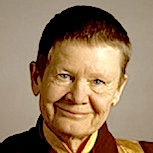
Pema Chödrön (Deirdre Blomfield-Brown)
1936 CE –
First American Vajrayana nun
Growing up on a New Jersey farm, studying elementary education at UC Berkeley in the 1950’s, and having a family life with two divorces and two children; Pema Chodrin came to Chögyam Trungpa and Tibetan Buddhism from a status-quo American background. From this ground, she became the first fully ordained American nun in the Vajrayana tradition, the first director of the first Tibetan Buddhist monastery in North America, and one of the most respected teachers in today’s world. Her 16 books, regular teaching and practice seminars continue to spread deep wisdom and authentic compassion.
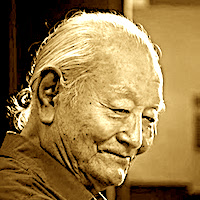
Namkhai Norbu ཆོས་རྒྱལ་ནམ་མཁའི་ནོར་བུ་
1938 – 2018 CE
Dzogchen Master
Great Dzogchen master, leading authority on Tibetan culture, and student of some of the most important, modern Tibetan masters; Namkhai Norbu studied and taught not only Buddhism but also history, medicine, and literature. Invited to teach at a university in Italy by the famous Tibetologist Giuseppe Tucci, he acted as a professor there for 28 years. Interest in his teachings grew and he established centers in Italy, China, Venezuela, the United States, Mexico, Argentina, Australia, Romania, Russia, Spain, and the Ukraine. He also founded a non-profit that works to increase the educational and medical resources in Tibet.
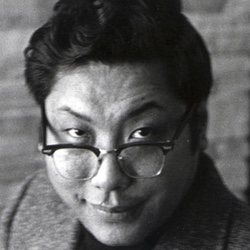
Chögyam Trungpa
1939 – 1987 CE
A once-in-a-generation kind of teacher, a mahasiddha for our times, a transducer transforming ancient wisdom into modern idiom. Per Allen Ginsberg, “A Renaissance man of the highest peaks of East, meditation emperor, space awareness Dance-master, witty rude calligrapher whose poetry and flower arrangements unite the Mind with Body… Prime Minister of Imagination… Chairman of the Board of Directors of Ordinary Mind.” Meditation master, scholar, teacher, poet, artist, he was honored as a mahasiddha by teachers like Khyentse Rinpoche and the 16th Karmapa. “The father of Tibetan Buddhism in the US,” his influence was and remains beyond words.
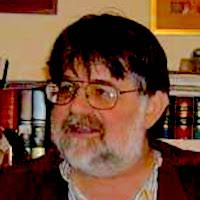
Robin Kornman
1947 – 2007 CE
Scholar, translator, Bodhisattva
Co-director of the first retreat center in the usa that Chögyam Trungpa Rinpoche set up in 1970 (Tail of the Tiger, name later changed by HH Karmpapa XVI to Karmê Chöling), co-founder Nalanda Translation Group, university professor, and one of the world's experts on the Gesar of Ling literature; Kornman began translation work on this famous Tibet oral epic in the 1980's and continued this focus until his untimely death in 2007 (because of asbestos exposure caused cancer when he was young). He devoted his life to helping others by teaching, challenging, and humorous but deeply insightful commentary.
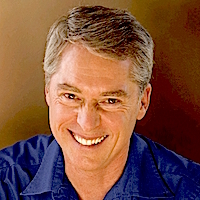
B. Alan Wallace (Bruce Alan Wallace)
1950 CE –
Translator, Tibetan Buddhist scholar, professor, and consciousness-studying scientist; Alan Wallace blended his 14 years as a monk and ordination by the 14th Dalai Lama with his scientific, research projects into understanding the nature of mind. He’s written 19+ books, many articles and papers, and translated innumerable Buddhist scriptures into understandable modern texts. However, his inclinations tend to gravitate more toward the words than the sense, the belief rather than the personal experience.
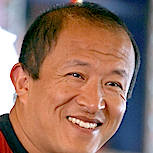
Dzongsar Khyentse Rinpoche རྫོང་གསར་ འཇམ་དབྱངས་ མཁྱེན་བརྩེ་ རིན་པོ་ཆེ། (Dzongsar Jamyang Khyentse Rinpoche)
1961 CE –
"Activity" incarnation of Jamyang Khyentse Wangpo
Filmmaker, writer, Tibetan lama, and active philanthropist; Dzongsar Rinpoche continues the traditions of the ecumenical Rimé school that began in the 1880s and of Dzongsar Khyentse Chokyi Lodro’s emphasis on bringing Tantric Buddhism to the West. The son of famous lama Thinley Norbu and grandson of Dudjom Rinpoche, he was a close student of Dilgo Khyentse. His philanthropic work began with a focus on the education, health and safety of exploited women and children in India and Cambodia and has spread around the world into a global volunteer network now strong in many countries. His 4 popular and award-winning movies entertain, educate, and spread insight into the timeless wisdom and compassion of realization.
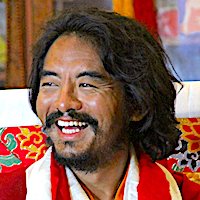
Mingyur Rinpoche
1975 CE –
Modern-day Mahasiddha
Major Dzogchen and Mahamudra lineage holder, descendant of the Tibetan kings Songtsen Gampo and Trisong Deutsen, abbot of Sherab Ling, and builder of Tergar Monastery; Mngyur Rinpoche left his elevated position in the middle of a 2011 night alone and taking nothing with him. For 4.5 years, he lived as an unknown yogi doing a “wandering retreat” in the Himalayas. He now has centers on 5 continents, teaches extensively, and continues his studies not only of Buddhist philosophy but also Western science and psychology.

Karmapa XVII ཨོ་རྒྱན་འཕྲིན་ལས་རྡོ་རྗ (Orgyen Thrinlay Dorje)
1985 CE –
Born in a remote part of Tibet to nomadic parents, when he was seven years old, Tai Situpa and the Dalai Lama recognized Ogyen Trinley as the 17th Karmapa. The Chinese government agreed and planned to train him to take over for the Dalai Lama. When he was 14 though, he secretly climbed out a window and escaped to India. Mired in political challenges, he focused his teachings on a practical compassion that protects the environment, saves animals, and engages in sustainable development projects teaching that planting trees is more beneficial than many religious practices.)
Related Sources (7 sources)
Tibetan Book of the Dead by Padmasambhava
Cutting Through Spiritual Materialism by Chögyam Trungpa
Our Oriental Heritage by Will Durant
Torch of Certainty by Jamgon Kongtrul the Great
Dzogchen: The Self-Perfected State by Namkhai Norbu
Gesar of Ling Epic by Gesar of Ling
Quotes about the Tibetan Vajrayana Lineage (9 quotes)
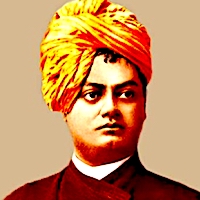
“The Buddhists or the Jains do not depend upon God; but the whole force of their religion is directed to the great central truth in every religion, to evolve a God out of man. They have not seen the Father, but they have seen the Son. And he that hath seen the Son hath seen the Father also.
”
Comments: Click to comment

“If there is any religion that would cope with modern scientific needs, it would be Buddhism.”
Comments: Click to comment
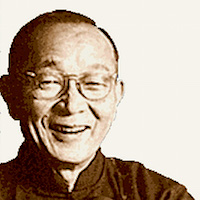
“He who talks about truth injures it; he who tries to prove it thereby maims and distorts it; he who gives it a label and a school of thought kills it; and he who declares himself a believer buries it.”
Comments: Click to comment
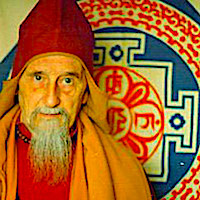
“While the Gelugpas had to qualify themselves through a long course of studies in one of the monastic universities, the highest qualificatiomn of a Kargyupa consisted in his ability to spend long periods in complete seclusion in caves, hermitages, meditation chambers”
Comments: Click to comment

“Suffering in hopefulness is the eternalist. Suffering in hopelessness is the nihilist. Beyond both hopefulness and hopelessness is the Buddhist.”
Comments: Click to comment

“It is not necessary for infinite players to be Christians; indeed it is not possible for them to be Christians... Neither is it possible for them to be Buddhists, or Muslims, or atheists, or New Yorkers... All such titles can only be playful abstractions”
Comments: Click to comment

“In general, people speak as if there is a kind of religion created by Buddha Shakyamuni. That is not a correct point of view. Buddha never created any kind of school or religion.”
Comments: Click to comment

“Tibetans virtually lived in the Middle Ages and, when they were thrust out by the communist invasion, they were forced to see twentieth-century life which became a kind of novelty.”
Comments: Click to comment
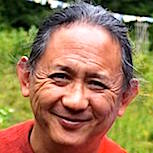
“We Tibetan refugees were poor and couldn't afford those things. In point of fact, we were living in harmony with nature and in balance with the environment—though we would not have recognized it as such.”
Comments: Click to comment
Comments (0)